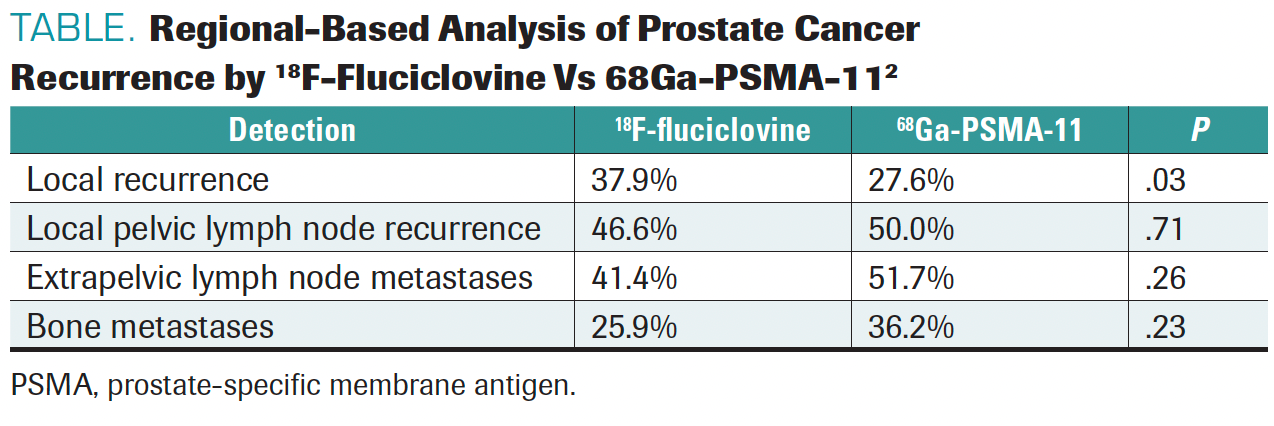18F-Fluciclovine Vs 68Ga-PSMA-11 Imaging for Prostate Cancer Biochemical Recurrence
Steven Finkelstein, MD, DABR, FACRO, and Louis J. Mazzarelli, MD, react to the manuscript titled, “A Prospective Head-to-Head Comparison of 18F-Fluciclovine With 68Ga-PSMA-11 in Biochemical Recurrence of Prostate Cancer in PET/CT,” by Birgit Pernthaler and colleagues.

Although prostate cancer is generally associated with high survival rates, 20% to 40% of patients with the disease will experience a recurrence.1 And since recurrence is usually identified by the presence of rising prostate-specific antigen (PSA) levels, clinicians are eager for improvements in imaging that may be useful for its detection.
Steven Finkelstein, MD; and Louis J. Mazzarelli, MD, recently discussed a published head-to-head comparison of 2 prostate cancer imaging techniques in a Between the Lines presentation hosted by CancerNetwork®. The manuscript by Birgit Pernthaler, MD, and colleagues, compared 18F-fluciclovine (Axumin) and 68Ga-PSMA-11 (Gallium Ga 68 PSMA-11) in PET/CT imaging from a sample of 58 patients with recurrent prostate cancer.2
“Some common sites of recurrence after a total radical prostatectomy include the vesicourethral anastomosis, the urinary bladder neck, and the rectovesical space,” said Finkelstein, a radiation oncologist with Florida Cancer Affiliates in Panama City, part of the US Oncology Network. “A local recurrence can occur at the site of the primary tumor in the prostate. However, the accurate detection of prostate cancer remains a challenge. Classically, we haven’t had the best imaging available.”
“Conventional imaging had many limitations with respect to the ability to identify recurrent prostate [transit-amplifying] cells,” said Mazzarelli, a diagnostic radiologist at Lawrence + Memorial Hospital in New London, Connecticut, part of the Yale Health Network.
CT scans, Mazzarelli continued, were not previously useful for imaging the prostate and surrounding areas. “Not uncommonly, over the last 15 years that I’ve been practicing, before the advent of incredibly exciting molecular imaging techniques, we were asked to identify prostate recurrence in patients with low or even high PSA [levels], and we weren’t able to do that with conventional imaging,” Mazzarelli said. “We weren’t able to see the anatomy locally.”
Newer methods, such as the advent of the 2 radiotracers, represented a huge change, Mazzarelli explained. “Of course, 18F-fluciclovine was the first, and now [68Ga-PSMA-11] is available,” he said. “It’s an exciting time.”
Mazzarelli and Finkelstein focused their conversation on findings from the study by Pernthaler et al, which indicated that 18F-fluciclovine detected prostate cancer recurrence at a rate of 79.3% vs 68Ga-PSMA-11 at 82.8% (P = .64).
“In terms of the physiology, 68Ga-PSMA-11 and Axumin are different in the sense that 68Ga-PSMA-11 has a PSMA-directed targeting membrane whereas Axumin is an amino acid–based compound,” said Mazzarelli.
“Therefore, the physiology in the body will be different. When we look at [18F-fluciclovine], we look at background uptake in muscle and bone and much less genitourinary or urinary excretion. When we look at PSMA [prostate-specific membrane antigen], we look at an agent that has more urinary excretion but is more sensitive with respect to uptake within bone and soft tissues.”
Radiotracer Performance
All 58 patients in the study had undergone either surgery or radiation therapy, and their median age was 70.1 years (range, 53-85). Patients had mean PSA levels of 14.9 ng/mL (range, 0.2-230.4) at the time of their scans and 16.6 ng/mL (range, 2.4-79.2) at the time they were diagnosed. The most common tumor stages were T3/T4 (57%), followed by T1/T2 (29%) and not determined (14%). Most patients had no nodal involvement (57%), 21% had undetermined nodal involvement, 19% had nodal status N1, and 3% had Nx nodal status. Approximately one-third (34%) had no metastases and 52% had undetermined metastases.
Although the 2 methods detected recurrence at similar rates overall, 18F-fluciclovine detected local recurrence in 37.9% of the overall sample of patients compared with 27.6% with 68Ga-PSMA-11. On the other hand, 18F-fluciclovine detected local pelvic lymph node recurrence, extrapelvic lymph node metastases, and bone metastases at lower rates than 68Ga-PSMA-11. However, Pernthaler and colleagues wrote that these differences were not statistically significant (TABLE).2
TABLE. Regional-Based Analysis of Prostate Cancer Recurrence by 18F-Fluciclovine Vs 68Ga-PSMA-112

A key takeaway from the paper, Finkelstein said, was “the advantage of 18F-fluciclovine in detecting curable, localized disease in close anatomic relation to the urinary bladder, whereas 68Ga-PSMA-11 fails because of accumulation of activity in the urinary bladder. However, 18F-fluciclovine is almost equivalent to 68Ga-PSMA-11 in detecting distant sites of prostate cancer,” he noted. “For most situations outside the urinary bladder area, 68Ga-PSMA-11 was superior.”
Mazzarelli commented that some nuance was necessary to interpret the results.
“That needs to be considered when we think about these radiotracers, because one radiotracer, we believe, outperforms the other when it comes to outside the [prostate] bed,” Mazzarelli explained. Specifically, future studies should focus on perfecting a technique for using both agents, he suggested.
“How would we optimize 68Ga-PSMA-11 or 18F-fluciclovine PSMA to perform better locally?” Mazzarelli continued. “One thing you do is acquire images—as some institutions have, like my own—beginning with the thighs going toward the vertex. You decrease the amount of radioactive tracer within the bladder. From a PSMA perspective, you have the patient void when they come to the imaging facility and right before getting onto the scanner.”
Implications for the Future
Both experts agreed that the paper carried implications for advancing the understanding of heterogeneity within the larger context of prostate cancer.
“We’re heading toward a theragnostic world where we’ll be able to use small-molecule targets to identify small volume of disease by a PSMA study
because most agents being developed are PSMA-based,” said Mazzarelli. “How does that affect a patient who has a 18F-fluciclovine study that is positive for lesions that the PSMA study doesn’t pick up? I believe these patients have some degree of heterozygosity. How that is impactful for the patient is another question.”
Finkelstein added that the findings showed promise in developing tailored treatments for patients based on the individual characteristics of their recurrence.
“Being a radiation oncologist, the theragnostic [implications] are exciting [to me],” Finkelstein said. “We’re able to take images to see exactly where there’s evidence of cancer recurrence and provide the right personalized therapy to target those sites of disease using radiation modalities.”
Finkelstein also noted that the increasing usage of piflufolastat F 18 (18F-DCFPyL; Pylarify) for PET imaging following its FDA approval in 2021 is bound to shed new light on imaging for prostate cancer recurrence.3
“A limitation previously had been where you could get gallium scans,” Finkelstein said. “With the advent of 18F-DCFPyL scans, [we might see
research regarding] postprostatectomy and postradiation therapy and the differences between 18F-fluciclovine and PSMA-PET to detect recurrences in prostate cancer.”
“From an imaging perspective, this is a new era,” Mazzarelli agreed. “We’re very lucky in many ways to have 2 outstanding radiotracers that allow us to identify disease. Both have potential utility in the future, even in the world of tumoral heterozygosity, or [maybe it will turn out that] one agent is more focused toward local recurrence and the other one more [distant].”
“It’s important, because these tumors will perform differently. But equally, we have [technologies on the] horizon that will save a lot of people’s lives,”
Mazzarelli concluded.
References
- Chau A, Gardiner P, Colletti PM, Jadvar H. Diagnostic performance of 18F-fluciclovine in detection of prostate cancer bone metastases. Clin Nucl Med. 2018;43(7):e226-e231. doi:10.1097/RLU.0000000000002130
- Pernthaler B, Kulnik R, Gstettner C, Salamon S, Aigner RM, Kvaternik H. A prospective head-to-head comparison of 18F-fluciclovine with 68Ga-PSMA-11 in biochemical recurrence of prostate cancer in PET/CT. Clin Nucl Med. 2019;44(10):e566-e573. doi:10.1097/RLU.0000000000002703
- Lantheus receives U.S. FDA approval of Pylarify (piflufolastat F 18) injection, the first and only commercially available PSMA PET imaging agent for prostate cancer. News release. Lantheus Holdings; May 27, 2021. Accessed February 8, 2022. https://bwnews.pr/3p2wCKD
Newsletter
Stay up to date on recent advances in the multidisciplinary approach to cancer.
Navigating Treatment Intensification in Metastatic Hormone-Sensitive Prostate Cancer
A patient case of a 50-year-old man with hormone-sensitive prostate cancer sparked a debate among oncologists regarding the best course of action.